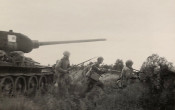
The offensive operation of the USSR armed forces against the Japanese forces in the course of the Soviet-Japanese War
After the surrender of Nazi Germany, the center of World War II in the Asia-Pacific Region remained, where militarist Japan acted as an aggressor.
On August 8, 1945, the USSR People's Commissar for Foreign Affairs V. Molotov handed over a statement to the Japanese government that the Soviet Union joined the Potsdam Declaration and, accepting the Allies' proposal to join the fight against the aggressor, from August 9, will consider itself at war with Japan. The main events of the war occurred on the territory of northeastern China. Simultaneously with the offensive in Manchuria, Soviet troops launched military operations on Sakhalin and the Kurile Islands.
The offensive operation of Soviet troops of August 11–25 to liberate South Sakhalin during World War II, 1939–1945 was conducted by the troops of the 56th rifle corps of the 16th Army of the 2nd Far Eastern Front (Army Commander General M. A. Purkayev) in cooperation with ships and marine units of the North Pacific Flotilla (STF) of the Pacific Fleet (Commander Admiral I. S Yumashev). The troops of the 88th Japanese Infantry Division, part of the border gendarmerie, and reservist detachments defended themselves on South Sakhalin. Long-term defenses were built on the island. The center of defense was the Koton fortified area.
The offensive began on August 11 and was supported by two aviation divisions. By the end of August 18, Soviet troops captured all heavily fortified strongholds in the border zone. On August 16, amphibious assault forces were landed on the west coast near Toro (now Shakhtersk). From August 19 to 25, naval (to Otomari, besides and airborne) landings were landed in the ports of Maoka (now Kholmsk) and Ottomari (now Korsakov). On August 25, the administrative center of South Sakhalin, the city of Toyohara (now Yuzhno-Sakhalinsk), was occupied. 18320 Japanese soldiers and officers yielded themselves prisoners.
From August 19 to September 1, 1945, the Soviet troops carried out the final landing operation of World War II - the Kuril landing operation. The plan of the Soviet command in the Far East envisaged actions on the islands of the archipelago from two directions. From the north - by the forces of the Kamchatka defense region it was planned to occupy the islands of Shumshu, Paramushir and further up to and including Urup. Then, after the liberation of South Sakhalin, the STOF ships were to ensure the landing of parts of the 87th infantry corps on the islands of Iturup, Kunashir, Shikotan and others belonging to the Small Kuril Ridge. Victory in the North Kuril Islands came at a high price. In the battles for the islands of Shumshu and Paramushir, Soviet troops suffered more than one and a half thousand people killed and wounded. Hundreds of soldiers were awarded state awards, nine of them - A. R. Gnechko, D. G. Ponomarev, P. I. Shutov, T. A. Pochtaryov, V. A. Kot, V. I. Sigov, and posthumously N. A. Vilkov, P. I. Il'ichev, S. A. Savushkin - received the title of Hero of the Soviet Union. The total number of prisoners as a result of the Kuril landing operation exceeded 50 thousand people.
On September 2, the American battleship Missouri signed the act of unconditional surrender of Japan in Tokyo Bay. World War II has been over. As a result of the war, the Soviet Union regained itself lost as a result of defeat in the Russian-Japanese war of 1904-1905. South Sakhalin received the Kuril Islands, which were the basis of Japanese aggression in the Pacific.
Lit.: Костанов А. И. Боевые действия на Южном Сахалине и Курильских островах в период советско-японской войны 1945 года // История Сахалина и Курильских островов с древнейших времён до начала XXI столетия. Южно-Сахалинск, 2008. С. 447–453; Земля, на которой живём. Южно-Сахалинск, 2007. С. 41; Вишневский Н. В. Сахалин и Курильские острова в годы Второй мировой войны. Южно-Сахалинск, 2000. С. 147–152.
Based on the Presidential Library’s materials:
USSR entered the war with Japan // On this day. 9 August 1945;
Anniversary of Korea liberation by Soviet Army // On this day. 15 August 1945;
Soviet-Japanese War of 1945: [digital collection];
1945: From the War to the Post-War World: [digital collection].
The material has been provided by the Sakhalin Regional Universal Research Library

